Suunto 5 User guide
Navigation
Altitude navigation
If you are navigating a route that has altitude information, you can also navigate based on ascent and descent using the altitude profile display. While in the main navigation display (where you see your route), press the middle button to switch to the altitude profile display.
The altitude profile display shows you the following information:
- top: your current altitude
- center: altitude profile showing your current position
- bottom: remaining ascent or descent (press the upper left button to change views)
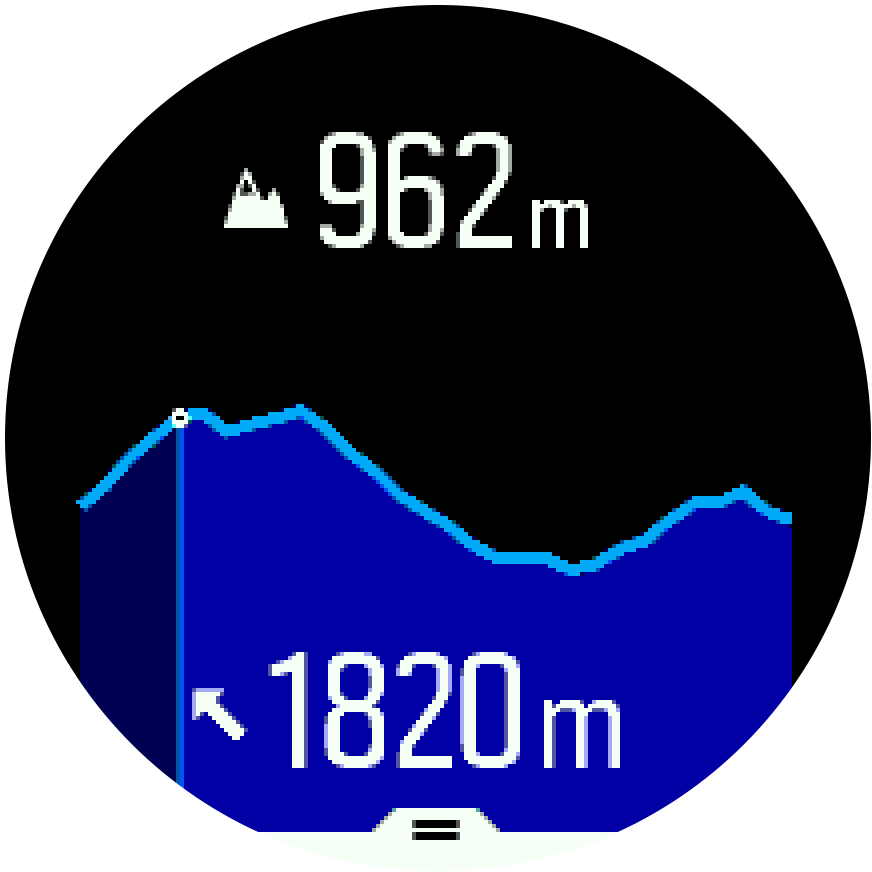
If you stray too far off from the route while using altitude navigation, your watch will give you an Off route message in the altitude profile display. If you see this message, scroll to the route navigation display to get back on track before continuing with altitude navigation.
Altimeter
Suunto 5 uses GPS to measure altitude. Under optimal signal conditions, eliminating potential errors typical in calculating GPS position, the GPS altitude reading should give a pretty good indication of your elevation.
Because Suunto 5 relies solely on GPS to measure altitude, if the GPS is not set for maximum accuracy, any filtering is subject to error and may result in potentially inaccurate altitude readings.
If you need good elevation readings, ensure your GPS accuracy is set to Best during the recording.
However, even with the best accuracy, GPS altitude should not be considered an absolute position. It is an estimation of your real elevation, and the accuracy of this estimation is heavily dependent on the surrounding conditions.
Routes
You can use your Suunto 5 to navigate routes.
To navigate on a route:
- Press the upper right button to open the launcher.
Scroll to Navigation and press the middle button.
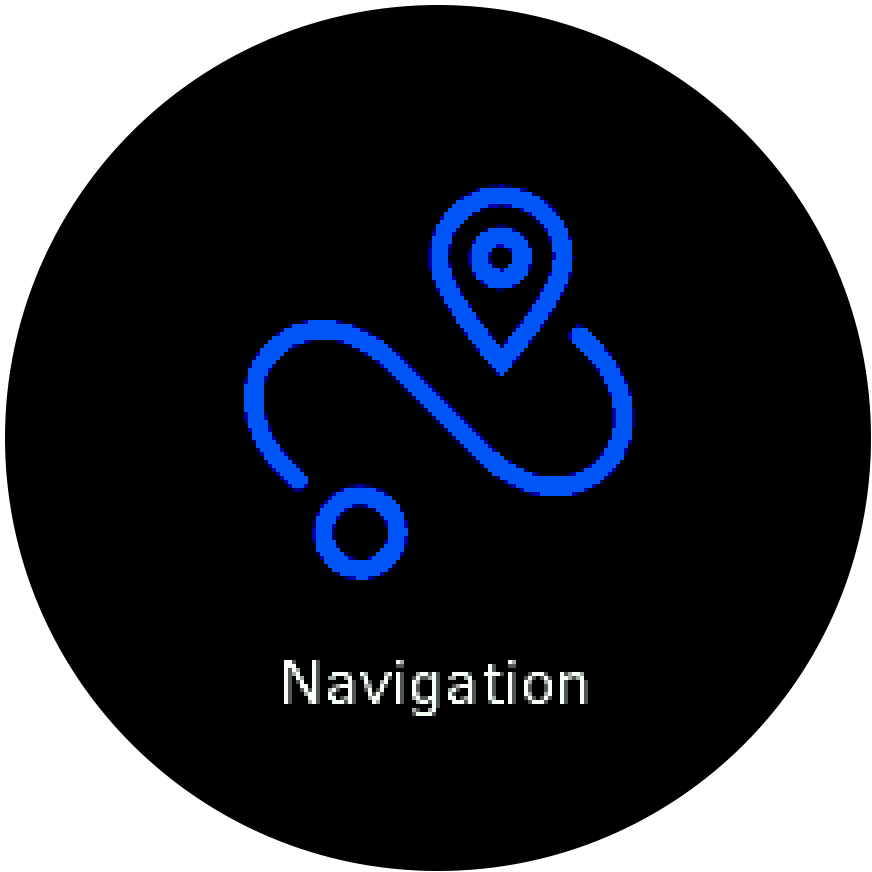
Scroll to Routes and press the middle button to open your list of routes.
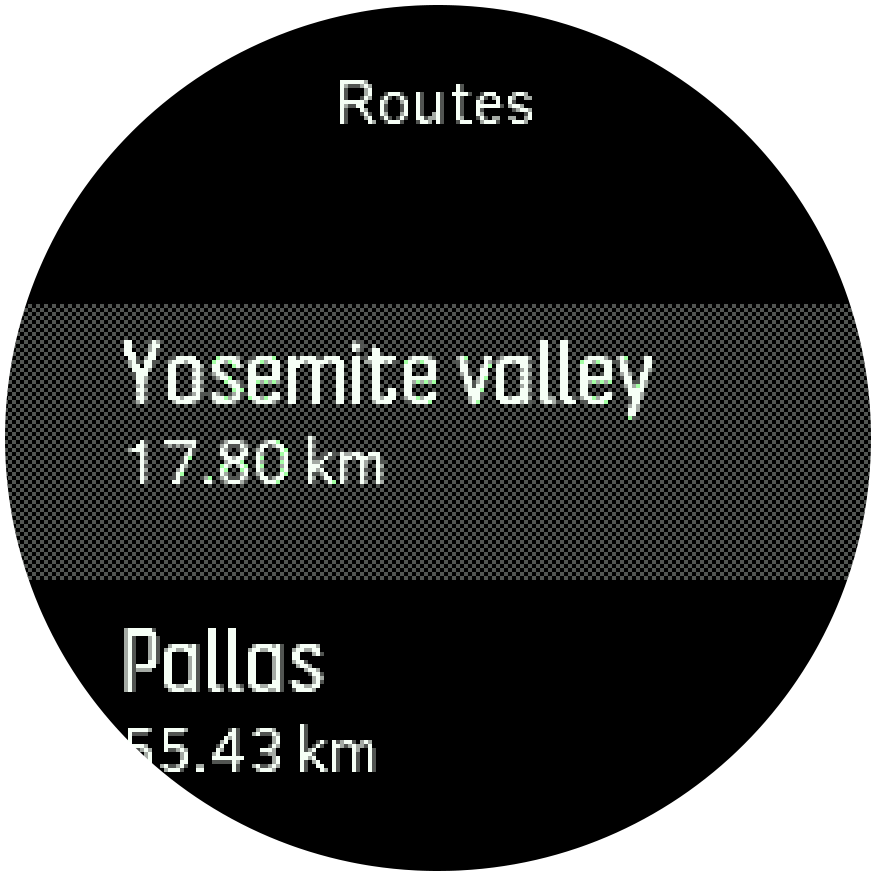
Scroll to the route you want to navigate to and press the middle button.
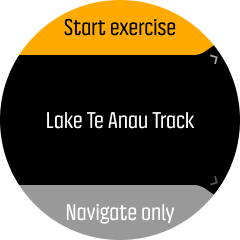
Select Start exercise if you want to use the route for exercising or select Navigate only if you only want to navigate the route.
NOTE:If you only navigate the route, nothing will be save or logged in Suunto app.
Press the upper right button again at any time to stop navigating.
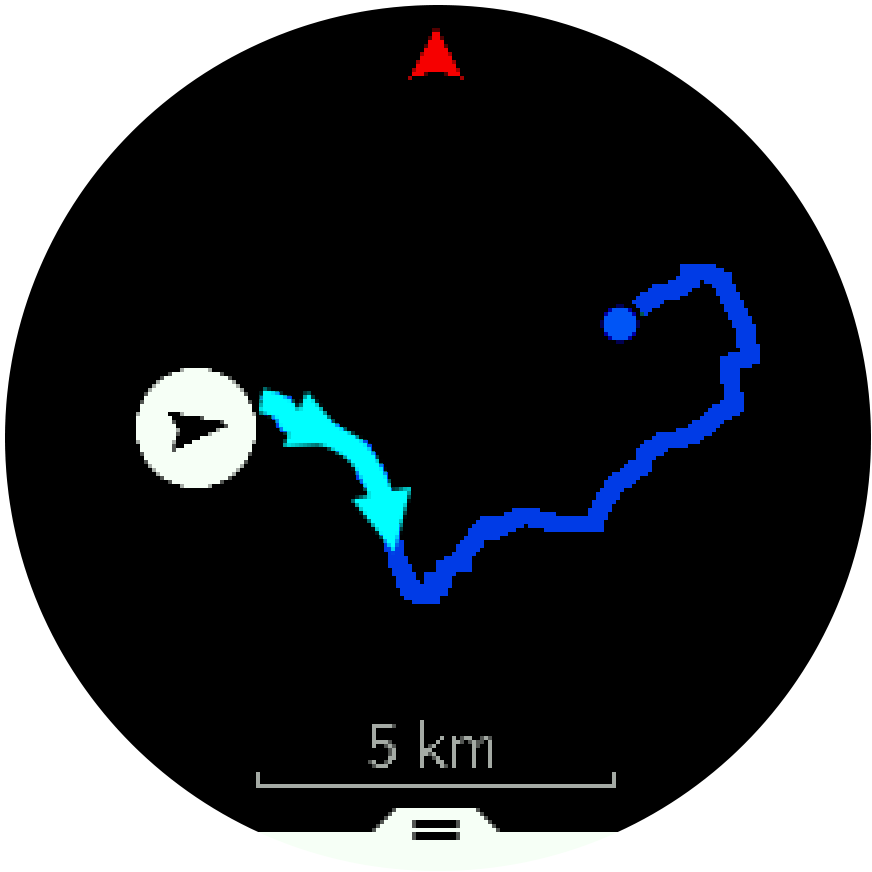
In the detailed view, zoom in and out by keeping the middle button pressed. Adjust the zoom level with the upper right and lower right buttons.
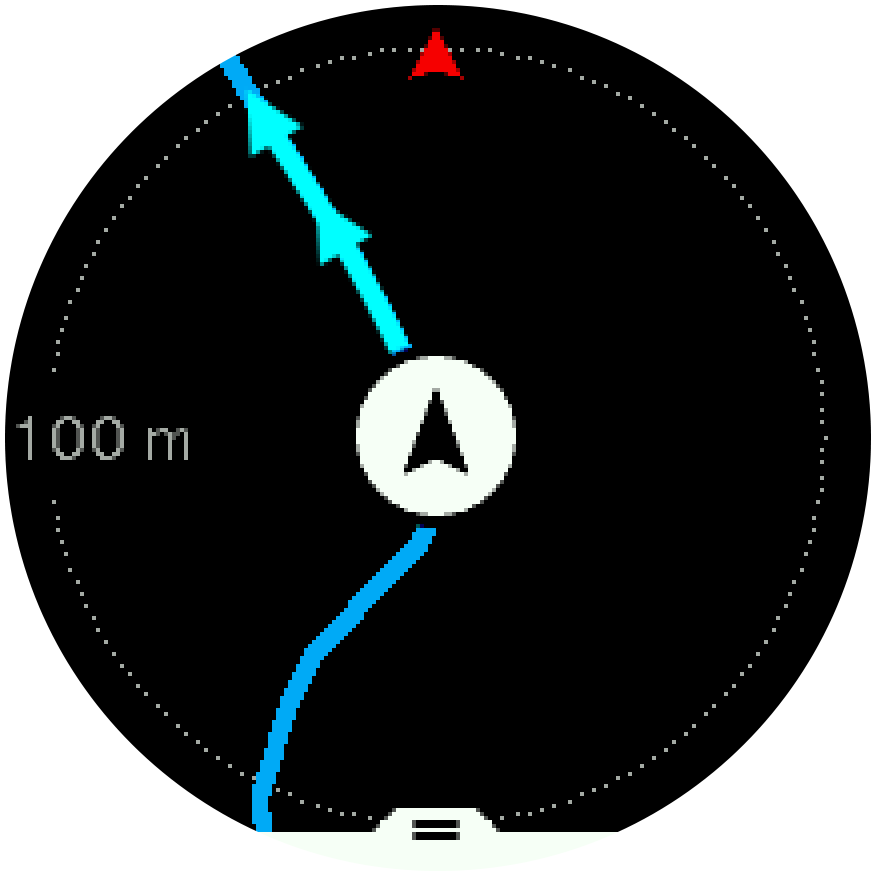
While you are in the navigation display, you can press the lower button to open a list of shortcuts. The shortcuts give you quick access to navigation actions such as saving your current location or selecting another route to navigate.
It is also possible to start an exercise from the shortcut list. Selecting Start exercise will open the sport modes menu and you can start recording your exercise. If you end the exercise, the navigation will also end.
All sport modes with GPS also have a route selection option. See Navigating during exercise.
Navigation guidance
As you navigate a route, your watch helps you stay on the correct path by giving you additional notifications as you progress along the route.
For example, if you go more than 100 m (330 ft) off route, the watch notifies you that you are not on the right track, as well as lets you know when you are back on route.
Once you reach a waypoint of POI on the route, you get an informative popup showing you the distance and estimated time en route (ETE) to the next waypoint or POI.
If you navigating a route that crosses itself, such as a figure-8, and you make a wrong turn at the crossing, your watch assumes you are intentionally going in a different on the route. The watch shows the next waypoint based on the current, new direction of travel. So, keep an eye on your breadcrumb trail to ensure you are going the right way when you are navigating a complicated route.
Turn-by-turn navigation
When creating routes in Suunto app, you can choose to activate turn-by-turn instructions. When the route is transferred to your watch and used for navigation, it will give you turn-by-turn instructions with a sound alert and information on which way to turn.
Find back
If you are using GPS when recording an activity, Suunto 5 automatically saves the starting point of your exercise. With Find back, Suunto 5 can guide you directly back to your starting point.
To start find back:
- While you are recording an activity, press the middle button until you have reached the navigation display.
- Press the lower right button to open the shortcut menu.
- Scroll to Find back and press the middle button to select.
- Press the lower left button to exit and return to the navigation display.
The navigation guidance is shown as the last display on the selected sport mode.
Turn-by-turn navigation powered by Komoot
If you are a Komoot member, you can find or plan routes with Komoot and sync these to your Suunto 5 via Suunto app. In addition, your exercises recorded with your watch will automatically be synchronized to Komoot.
When using route navigation with your Suunto 5 together with routes from Komoot, your watch will give you turn-by-turn instructions with a sound alert and a text on which way to turn.
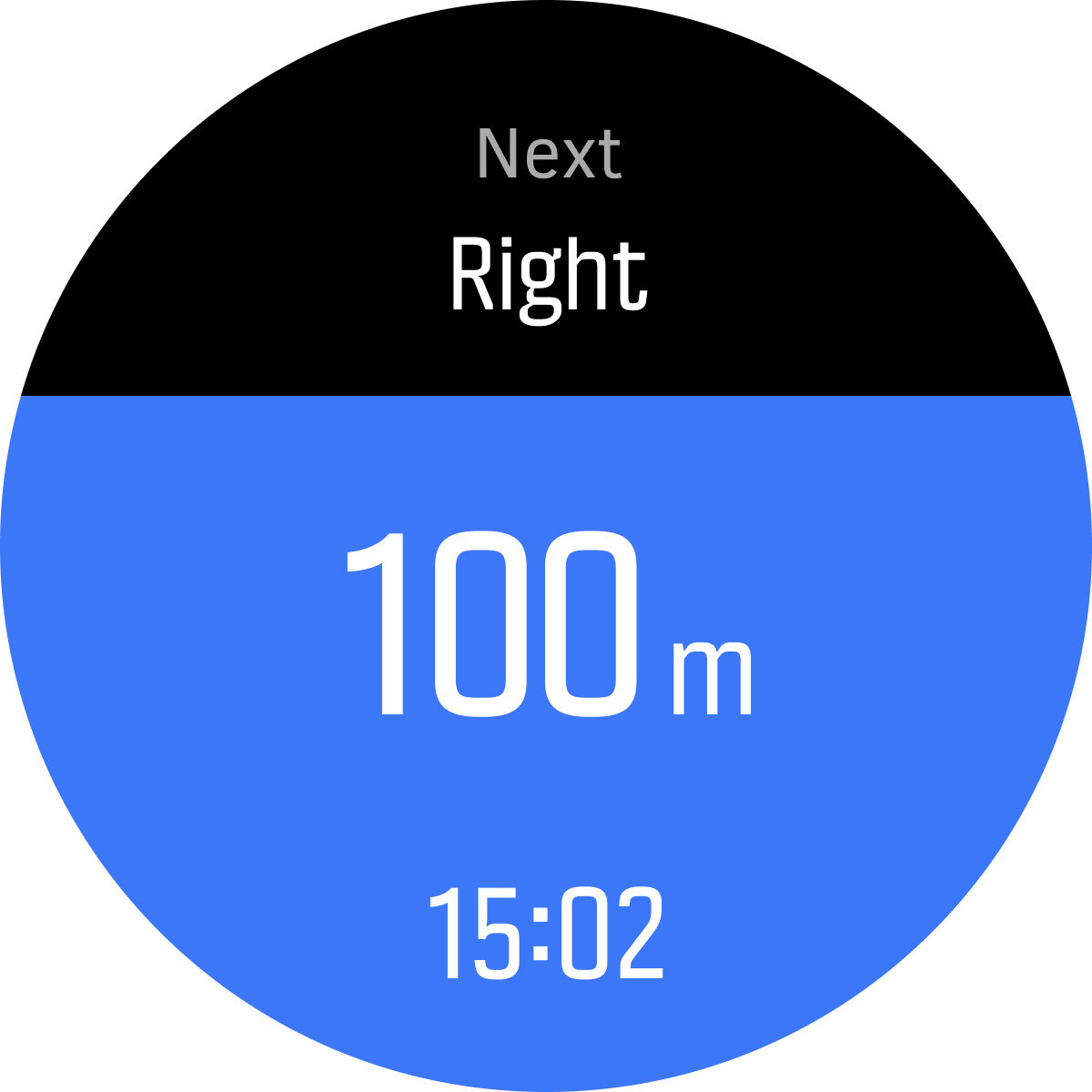
To use turn-by-turn navigation powered by Komoot:
- Register at Komoot.com
- In Suunto app, select partner services.
- Select Komoot and connect by using the same credentials you used at the Komoot registration.
All your selected or planned routes (called “tours” in Komoot) in Komoot will automatically synchronize to Suunto app, which you then easily can transfer to your watch.
Follow the instructions in section Routes and select your route from Komoot to get turn-by-turn instructions.
For more information regarding the partnership between Suunto and Komoot, please see http://www.suunto.com/komoot
Komoot is currently not available in China.
Points of interest
A point of interest, or POI, is a special location, such as camping spot or vista along a trail, you can save and navigate to later. You can create POIs in Suunto app from a map and do not have to be at the POI location. Creating a POI in your watch is done by saving your current location.
Each POI is defined by:
- POI name
- POI type
- Date and time created
- Latitude
- Longitude
- Elevation
You can store up to 250 POIs in your watch.
Navigating to a POI
You can navigate to any POI that is in your watch POI list.
When navigating to a POI, your watch uses full power GPS.
To navigate to a POI:
- Press the upper right button to open the launcher.
- Scroll to Navigation and press the middle button.
- Scroll to POIs and press the middle button to open your list of POIs.
- Scroll to the POI you want to navigate to and press the middle button.
- Press the upper button to start navigating.
To stop navigating, press the upper button again at any time.
While you are moving, the POI navigation has two views:
POI view with direction indicator and distance to the POI
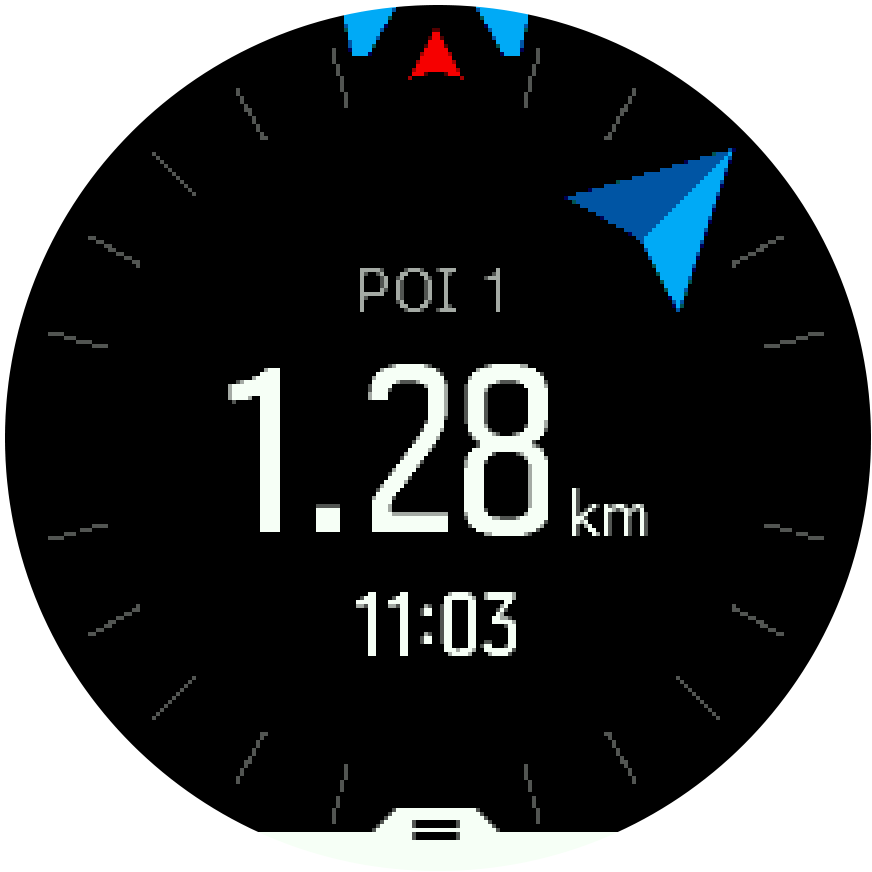
map view showing your current location relative to the POI and your breadcrumb trail (the track you have traveled)
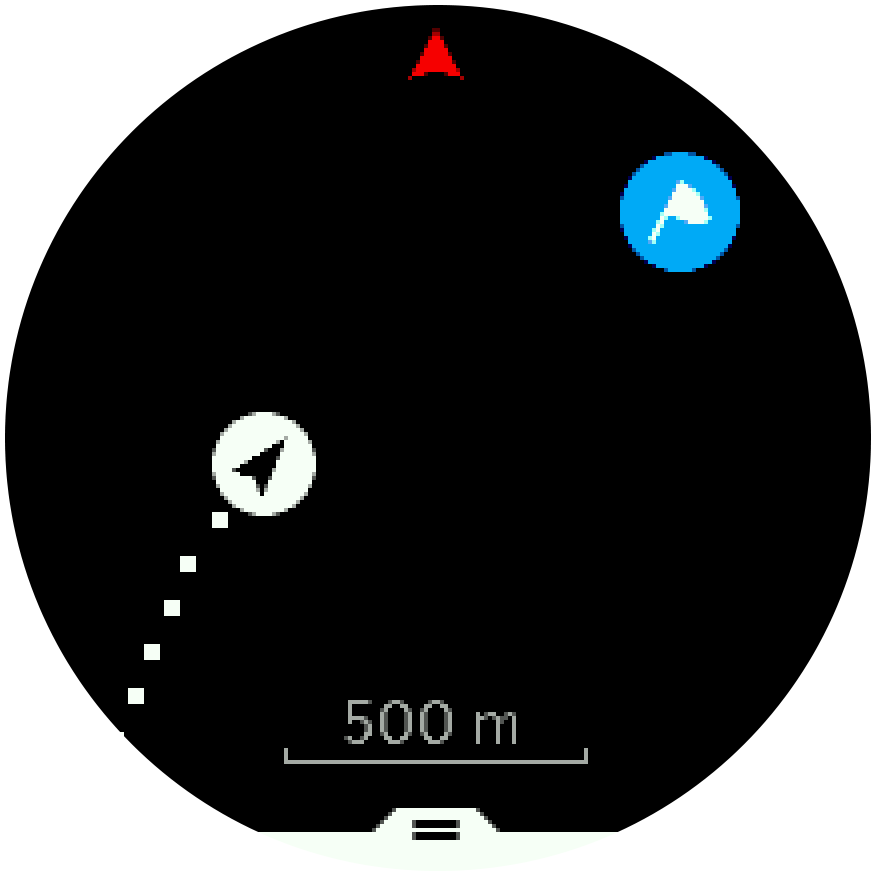
Press the middle button to switch between views. If you stop moving, the watch cannot determine which direction you are going based on GPS.
While in the POI view, tap on the screen to see additional information in the lower row such as altitude difference between current position and POI and estimated time of arrival (ETA) or en route (ETE).
In the map view, other POIs nearby are shown in gray. Press the upper left button to switch between the overview map and a more detailed view. In the detailed view, you adjust the zoom level by pressing the middle button and then zooming in and out with the upper and lower buttons.
While navigating, press the lower right button to open a list of shortcuts. The shortcuts give you quick access to POI details and actions such as saving your current location or selecting another POI to navigate to, as well as ending navigation.
POI types
The following POI types are available in Suunto 5:
| generic point of interest | |
| Bedding (animal, for hunting) | |
| Begin (start of a route or trail) | |
| Big game (animal, for hunting) | |
| Bird (animal, for hunting) | |
| Building, home | |
| Cafe, food, restaurant | |
| Camp, camping | |
| Car, parking | |
| Cave | |
| Cliff, hill, mountain, valley | |
| Coast, lake, river, water | |
| Crossroad | |
| Emergency | |
| End (end of a route or trail) | |
| Fish, fishing spot | |
| Forest | |
| Geogache | |
| Hostel, hotel, lodging | |
| Info | |
| Meadow | |
| Peak | |
| Prints (animal tracks, for hunting) | |
| Road | |
| Rock | |
| Rub (animal marking, for hunting) | |
| Scrape (animal marking, for hunting) | |
| Shot (for hunting) | |
| Sight | |
| Small game (animal, for hunting) | |
| Stand (for hunting) | |
| Trail | |
| Trail cam (for hunting) | |
| Waterfall |
Adding and deleting POIs
You can add a POI to your watch either with Suunto app or by saving your current location in the watch.
If you are outside with your watch and come across a spot you want to save as a POI, you can add the location directly in your watch.
To add a POI with your watch:
- Press the upper button to open the launcher.
- Go to Navigation and press the middle button.
- Press the lower button to scroll down to Your location and press the middle button.
- Wait for the watch to activate GPS and find your location.
- When the watch displays your latitude and longitude, press the upper button to save your location as a POI and select the POI type.
- By default the POI name is the same as the POI type (with a running number after it).
Deleting POIs
You can remove a POI by deleting the POI from the POI list in the watch or removing it in Suunto app.
To delete a POI in your watch:
- Press the upper button to open the launcher.
- Go to Navigation and press the middle button.
- Press the lower button to scroll down to POIs and press the middle button.
- Scroll to the POI you want to remove from the watch and press the middle button.
- Scroll to the end of the details and select Delete.
When you delete a POI from your watch, the POI is not permanently deleted.
To permanently delete a POI, you need to delete the POI in Suunto app.
GPS accuracy and power saving
The GPS fix rate determines the accuracy of your track - the shorter the interval is between fixes, the better the track accuracy is. Each GPS fix is recorded in your log when recording an exercise.
The GPS fix rate also directly affects battery life. By reducing GPS accuracy, you can extend the battery life of your watch.
The GPS accuracy options are:
- Best: ~ 1 sec fix rate
- Good: ~ 60 sec fix rate
You can change GPS accuracy from the sport options in your watch or in Suunto app.
Whenever you navigate a route or a POI, the GPS accuracy is automatically set to Best.
The first time you exercise or navigate with GPS, wait for the watch to acquire a GPS fix before starting. This may take 30 seconds or more depending on conditions.